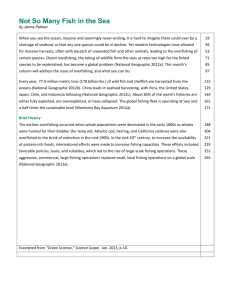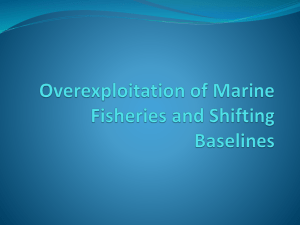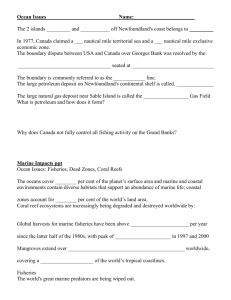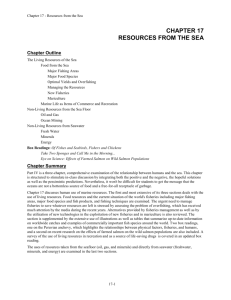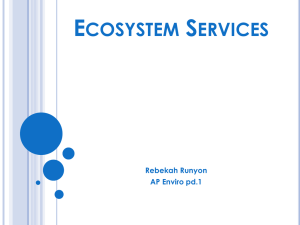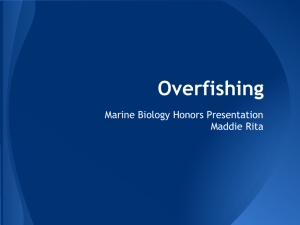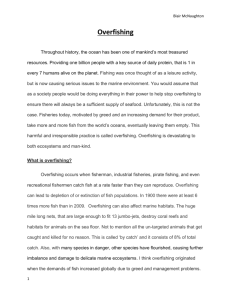overfishing - Waitt Institute
advertisement
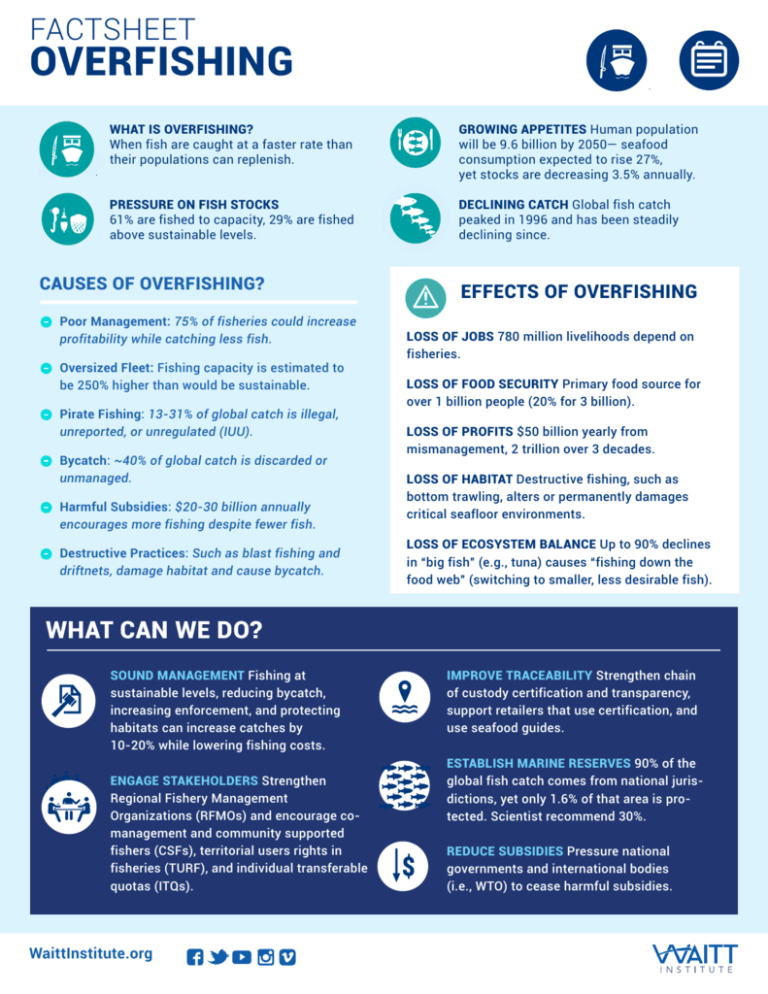
FACTSHEET OVERFISHING WHAT IS OVERFISHING? When fish are caught at a faster rate than their populations can replenish. GROWING APPETITES Human population will be 9.6 billion by 2050— seafood consumption expected to rise 27%, yet stocks are decreasing 3.5% annually. PRESSURE ON FISH STOCKS 61% are fished to capacity, 29% are fished above sustainable levels. DECLINING CATCH Global fish catch peaked in 1996 and has been steadily declining since. CAUSES OF OVERFISHING? Poor Management: 75% of fisheries could increase profitability while catching less fish. Oversized Fleet: Fishing capacity is estimated to be 250% higher than would be sustainable. Pirate Fishing: 13-31% of global catch is illegal, unreported, or unregulated (IUU). Bycatch: ~40% of global catch is discarded or unmanaged. Harmful Subsidies: $20-30 billion annually encourages more fishing despite fewer fish. Destructive Practices: Such as blast fishing and driftnets, damage habitat and cause bycatch. EFFECTS OF OVERFISHING LOSS OF JOBS 780 million livelihoods depend on fisheries. LOSS OF FOOD SECURITY Primary food source for over 1 billion people (20% for 3 billion). LOSS OF PROFITS $50 billion yearly from mismanagement, 2 trillion over 3 decades. LOSS OF HABITAT Destructive fishing, such as bottom trawling, alters or permanently damages critical seafloor environments. LOSS OF ECOSYSTEM BALANCE Up to 90% declines in “big fish” (e.g., tuna) causes “fishing down the food web” (switching to smaller, less desirable fish). WHAT CAN WE DO? SOUND MANAGEMENT Fishing at sustainable levels, reducing bycatch, increasing enforcement, and protecting habitats can increase catches by 10-20% while lowering fishing costs. ENGAGE STAKEHOLDERS Strengthen Regional Fishery Management Organizations (RFMOs) and encourage comanagement and community supported fishers (CSFs), territorial users rights in fisheries (TURF), and individual transferable quotas (ITQs). WaittInstitute.org IMPROVE TRACEABILITY Strengthen chain of custody certification and transparency, support retailers that use certification, and use seafood guides. ESTABLISH MARINE RESERVES 90% of the global fish catch comes from national jurisdictions, yet only 1.6% of that area is protected. Scientist recommend 30%. REDUCE SUBSIDIES Pressure national governments and international bodies (i.e., WTO) to cease harmful subsidies. “ Overfishing is the world’s biggest solvable environmental problem.” KEY WEBSITES Dr. Callum Roberts EXPERTS VIDEO Monterey Bay Aquarium Seafood Watch Ocean 2012 | Ending Overfishing www.seafoodwatch.org/ocean-issues/wildseafood www.youtube.com/watch?v=I6_mbozoqL8 National Geographic ocean.nationalgeographic.com/ocean/globalfish-crisis-article/ Callum Roberts | The Unnatural History of the Sea www.youtube.com/watch?v=xECNAvjgr8Q World Wildlife Foundation | Overfishing Oceana | How Saving the Oceans Can Feed the World www.worldwildlife.org/threats/overfishing www.youtube.com/watch?v=tBoIHk7_fxg Ocean Health Index Running Out of Fish www.oceanhealthindex.org/Components/ Stock_Status/ www.youtube.com/watch?v=PhDbJL1V0mc Jeremy Jackson, Ph.D. Scripps Institution of Oceanography, Smithsonian Institution Daniel Pauly, Ph.D. Director Fisheries Centre, University of British Columbia, Principal Investigator, Sea Around Us Callum Roberts, Ph.D. Professor of Marine Conservation University of York Boris Worm, Ph.D. Professor of Biology Dalhousie University, Nova Scotia Oceana | Responsible Fishing Campaign oceana.org//our-campaigns/promote_ responsible_fishing/campaign Smithsonian Ocean Portal | Overfishing Ussif Rashid Sumaila, Ph.D. Director, Fisheries Economics Research Unit, University of British Columbia ocean.si.edu/conservation/overfishing REFERENCES 1. Ainley, D. and D. Pauly. 2013. Fishing down the food web of the Antarctic continental shelf and slope. Antarctic Record. 2. Costello, C., et al. 2012. Status and solutions for the world’s unassessed fisheries. Science. 338. 517. Hard Facts, Hidden Problems: A Review of Current Data on Fishing Subsidies. WWF Technical Paper, October 2001. 3. Davies R.W.D., et al. 2009. Defining and estimating global marine fisheries bycatch. Marine Policy. doi:10.1016/j.marpol.2009.01.003. 4. FAO. 2014. The State of the World’s Fisheries and Aquaculture SOFIA. 5. FAO. 2005-2014. World inventory of fisheries. Destructive fishing practices. Issues Fact Sheets. Text by S.M. Garcia. Rome. 6. Jackson, J.B.C., M.X. Kirby, W.H. Berger, K.A.Bjorndal, L.W.Botsford, B.J. Bourque, R. Bradbury, R. Cooke, J. Erlandson, J.A. Estes, T.P. Hughes, S. Kidwell, C.B. Lange, H.S. Lenihan, J. M. Pandolfi, C.H. Peterson, R. S. Steneck, M.J. Tegner, and R. Warner. 2001. Historical overfishing and the recent collapse of coastal ecosystems. Science 293:629-638. 7. Pramod, G., Nakamura, K., Pitcher, T. J., and Delagran, L. 2014. Estimates of illegal and unreported fish in seafood imports to the USA. Marine Policy, 48, 102-113. 8. Sharpless A. and M. Hirshfield. 2012. Saving the oceans can feed the world. Frontiers in Ecology and the Environment 10: 399–399. 9. Sumaila, U. R., A. Khan, R. Watson, G. Munro, D. Zeller, N. Baron, and D. Pauly. 2007. The World Trade Organization and global fisheries sustainability. Fisheries Research 88:1–4. 10. UNEP. 2006. Challenges to International Waters – Regional Assessments in a Global Perspective. United Nations Environment Programme, Nairobi, Kenya. 11. Wood, L.J., L. Fish, J. Laughren, and D. Pauly. 2008. Assessing progress towards global marine protection targets: shortfalls in information and action. Oryx, 42, pp 340-351. 12. World Bank. 2013. Fish to 2030: prospects for fisheries and aquaculture. Agriculture and environmental services discussion paper; no. 3. Washington DC; World Bank Group. Updated: 30 January 2015 RELATED FACTSHEETS Sustainable Seafood, Blue Economy, IUU, Sharks, Traceability Available: WaittInstitute.org/factsheets WaittInstitute.org
